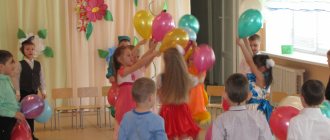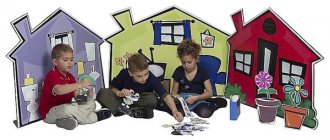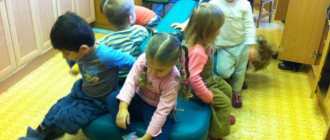Federal State Educational Standards requirements for creation and design in preschool educational institutions
According to the requirements of the educational standard, an activity corner must be provided in a well-lit place. Furniture and materials must be of high quality. The content of the corner should correspond to the age of preschool children, and creative materials must be changed from time to time or supplemented with new ones.
The most optimal furniture for a corner is a cabinet with open shelves on which you can place inspiring items (albums, reproductions of paintings), and isolate the materials necessary for creativity (paper, glue, scissors) from children and store them in a closed bedside table or drawers. Or it could be a table combined with a shelving unit.
For your information! For organized storage of all necessary materials (cardboard, paints, plasticine), you can use boxes of different colors or plain ones with bright symbols of the contents.
Preview:
METHODOLOGICAL RECOMMENDATIONS FOR DESIGNING ARTS CORNERS IN GROUPS
Goal: To create an environment in the group for the creative activity of children, to promote the emergence and development of independent artistic activity in preschool children.
CONDITIONS FOR DESIGNING CORNERS:
1.Location of the visual arts area: accessibility, aesthetics, mobility.
2. Using children's design and creativity in design. 3. Compliance with age requirements.
4. Variety of didactic material and its correspondence to age characteristics, incl. availability of innovative material.
5.Location of material at children's level.
-Paper of different sizes, shapes, textures and colors.
-colored pencils from 12 to 24 pcs.
— watercolor 12-16 colors
- jars for washing brush bristles from paint, napkins made of fabric that absorbs water well, for drying the brush
- colored wax crayons, felt-tip pens
- plasticine, stacks, boards and napkins for modeling, oilcloth for covering tables
— mounted rollers with paper rolls
- school crayons for drawing on the blackboard and asphalt or linoleum.
— Stencils of dishes, vegetables, fruits, etc. Silhouettes of animals, birds and humans.
— Objects of decorative and applied art with elements of painting (haze, Gorodets, etc. according to the program)
— Sculptures of small forms.
— Dummies of vegetables, fruits, berries
— Coloring pages for girls and boys.
— Illustrations based on fairy tales, seasons, made in different styles.
— Thematic folders with children’s work in independent activities. — Material for non-traditional drawing techniques: pokes, candles, toothbrushes, cotton swabs, stamps.
- natural and waste material
— Paint mixing samples (e.g. white + red = pink, etc.)
- Availability of a playable character.
— Various techniques of fine art (samples);
— Development of compositional skills, rhythm (educational and visual material, didactic games).
— Material on genres of painting, portraits of artists, styles of architecture, book graphics, taking into account the age of children.
— Albums with photos corresponding to the theme of the week.
— Corner of artistic manual labor.
— Availability of technological maps, diagrams of the sequence of drawing, modeling, applications, taking into account age and gender specifics.
In older preschool age, it is important to develop any manifestations of the “self” of preschoolers: independence, self-organization, self-esteem, self-control, self-knowledge, self-expression. Therefore, the visual arts corner is organized in such a way that every child has the opportunity to engage in any activity. Placing equipment according to the principle of non-rigid centering allows children to unite into subgroups based on their interests.
All materials used in the visual arts corner are added to the corner as the program progresses; they are constantly updated and varied.
The teacher must change, supplement, and review the materials and equipment in the visual arts corner from time to time.
Most equipment and visual materials can be stored in boxes with pictures and writing.
Source
Drawing corner in kindergarten: DIY decoration
To attract the attention of children and inspire creativity, the art corner should be colorfully decorated, not forgetting the age of the children. In the younger group, it is not recommended to frequently change images, since at this age children are in the process of adaptation and any changes in the environment cause stress.
For your information! For children in the older group, it is important to support the initiative for creative self-expression - materials should always be available, and the teacher needs to create an atmosphere in which children consider themselves masters in the group.
To create a positive creative mood, you can draw or pin a picture on the wall - a fairy-tale castle from the land of creativity, a fairy-tale or cartoon character (little Raccoon, Pencil from Dunno, the cat Matroskin or Fixiki, etc.) with a palette, brush or pencil. The picture can also be changed, for example, after completing a topic or becoming familiar with new material or technique.
Pencil holders in the corner Fine art
An option for dotted design of a corner is possible - blots or silhouettes of children's hands pasted in different places, a rainbow due to clouds or drops of rain, a bright, catchy inscription, place paper holders in the shape of an animal on the shelves, a stand for brushes in the shape of a truck, pencils or glasses with funny faces.
Analysis of the design and operation of the art corner
In kindergartens, competitions are often held for the best design of the art corner.
An example of furniture arrangement in the fine arts corner
However, any teacher can analyze the pictorial corner in the kindergarten - you just need to answer the following questions:
An art corner organized in a group in a kindergarten helps develop a child’s creative abilities, instill artistic taste and teach children to independently look for ways to depict their fantasies.
Source
Contents of the ISO corner in the group
The most important component of the art zone in a group is its capacity. First of all, these are direct materials for creativity.
When filling the corner with mandatory materials, the age of the students is taken into account. So, at a younger age, colored pencils and felt-tip pens in primary colors are sufficient: black, red, yellow, blue and green (the same applies to colored paper for appliqué). Further, the color range expands as children grow older.
Scissors are offered to children only in the middle group and under the supervision of a teacher.
New materials are added as they are mastered (for example, watercolors, sanguine and charcoal in the middle group). The same applies to materials for non-traditional art techniques (for example, after students in the junior group have mastered drawing with cotton swabs in class, the teacher places them in the art area).
Source
Goal: To create an environment in the group for the creative activity of children, to promote the emergence and development of independent artistic activity in preschool children.
CONDITIONS FOR DESIGNING CORNERS:
1.Location of the visual arts area: accessibility, aesthetics, mobility.
2. Using children's design and creativity in design. 3. Compliance with age requirements.
4. Variety of didactic material and its correspondence to age characteristics, incl. availability of innovative material.
5.Location of material at children's level.
Art corner in a group: helping children unleash their creative potential
Thematic zones in the group are a prerequisite for the harmonious all-round development of preschoolers. The richness of their content, together with suitable design, will allow children to gain a great experience during their stay in kindergarten. One of the favorite activities of both younger and older preschoolers is drawing. A bright and rich in materials art corner will interest children even more in creative activities.
The importance of the art corner in kindergarten
Most preschoolers love to draw. They really like art classes in kindergarten, and therefore, in their free time, the children are happy to repeat their drawings and crafts. Many people like to color ready-made pictures, for example, on a certain theme (for girls - fairy-tale princesses, and for boys - cars, planes, etc.). Some people are interested in looking at albums with reproductions of paintings and elegant folk crafts (matryoshka dolls, wooden spoons, dishes, trays).
Many children in kindergarten enjoy coloring pictures in their free time.
All of these types of activities contribute to the creative development of preschoolers, and the child will be able to find a suitable activity in the art corner, which the teacher will equip specifically for this purpose. Children get the opportunity to reveal their potential and enrich their understanding of the beauty of the world around them.
The fine arts area is also designed for parents in the locker room in the form of a beautiful stand. After all, it is very interesting for mothers and fathers to see the drawings and crafts that their children have created with their own hands. This gives adults the opportunity to get in touch with the educational process in a preschool educational institution.
Parents enjoy looking at their children's drawings and crafts.
Preview:
METHODOLOGICAL RECOMMENDATIONS FOR DESIGNING ARTS CORNERS IN GROUPS
Goal: To create an environment in the group for the creative activity of children, to promote the emergence and development of independent artistic activity in preschool children.
CONDITIONS FOR DESIGNING CORNERS:
1.Location of the visual arts area: accessibility, aesthetics, mobility.
2. Using children's design and creativity in design. 3. Compliance with age requirements.
4. Variety of didactic material and its correspondence to age characteristics, incl. availability of innovative material.
5.Location of material at children's level.
- colored and white paper, a whole landscape sheet and half,
- wax crayons, felt-tip pens
— gouache in a set of 6 colors
— Stand for brushes, jars, napkins
- clay, plasticine, 3-4 types of stacks, napkins, boards for wiping hands.



